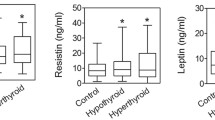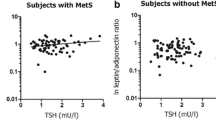Summary
Background
Subclinical hypothyroidism (SH) occurs when serum thyroid stimulating hormone (TSH) concentrations are raised and serum thyroid hormone concentrations are normal. The effect of SH on the proinflammatory adipose cytokine releasing visceral adipose tissue (VAT) is not clear. The aim of this study is to identify the difference between the pre and posttreatment levels of VAT, leptin, and resistin in SH patients.
Methods
There were 51 SH patients and 43 age- and gender-matched healthy subjects included in the study. Thyroid functions, biochemical tests, leptin, resistin, and visceral and subcutaneous fat measurements were made. The measurements were repeated in the SH group in the third month following L-thyroxin treatment.
Results
Initially, high sensitivity C-reactive protein, carotid artery intima-media thickness (mm), leptin, and resistin levels were significantly higher in the SH group compared to the controls, while the other parameters were similar. While no correlation was observed between TSH levels and adipokines, a positive correlation was detected between waist circumference and leptin levels (r = 0.549, p < 0.01). Visceral adipose tissue was positively correlated to age, waist circumference, and leptin levels, but negatively correlated to free thyroxin (T4) levels (r = 0.419, p = 0.009; r = 0.794, p < 0.01; r = 0.515, p < 0.01 and r = − 0.416, p = 0.009, respectively). A significant decrease was observed in VAT volume, leptin, and resistin levels of SH patients following levothyroxine treatment.
Conclusion
The reduced VAT volume, leptin, and resistin levels in SH patients following treatment may support the idea that TSH affects adipose tissue functions.
Similar content being viewed by others
References
Zamboni M, Armellini F, Turcato E, et al. Effect of regain of body weight on regional body fat distribution: comparison between pre- and postmenopausal obese women. Obes Res. 1996;4:555–60.
Fain JN, Madan AK, Hiler ML, Cheema P, Bahouth SW. Comparison of the release of adipokines by adipose tissue, adipose tissue matrix, and adipocytes from visceral and subcutaneous abdominal adipose tissues of obese humans. Endocrinology. 2004;145:2273–82.
Yusuf S, Hawken S, Ounpuu S, et al. Obesity and the risk of myocardial infarction in 27,000 participants from 52 countries: a case-control study. Lancet. 2005;366:1640–9.
Hirooka M, Kumagi T, Kurose K, et al. A technique for the measurement of visceral fat by ultrasonography: comparison of measurements by ultrasonography and computed tomography. Intern Med. 2005;44:794–9.
Cooper DS, Biondi B. Subclinical thyroid disease. Lancet. 2012;379:1142–54.
Rodondi N, Bauer DC, Cappola AR, et al. Subclinical thyroid dysfunction, cardiac function, and the risk of heart failure. The Cardiovascular Health study. J Am Coll Cardiol. 2008;52:1152–9.
Rodondi N, den Elzen WP, Bauer DC, Thyroid Studies Collaboration, et al. Subclinical hypothyroidism and the risk of coronary heart disease and mortality. JAMA. 2010;304:1365–74.
Fox CS, Pencina MJ, D’Agostino RB, et al. Relations of thyroid function to body weight: cross-sectional and longitudinal observations in a community-based sample. Arch Intern Med. 2008;168:587–92.
Hsieh CJ, Wang PW, Wang ST, et al. Serum leptin concentrations of patients with sequential thyroid function changes. Clin Endocrinol (Oxf). 2002;57:29–34.
Yaturu S, Prado S, Grimes SR. Changes in adipocyte hormones leptin, resistin, and adiponectin in thyroid dysfunction. J Cell Biochem. 2004;93:491–6.
Corbetta S, Englaro P, Giambona S, Persani L, Blum WF, Beck-Peccoz P. Lack of effects of circulating thyroid hormone levels on serum leptin concentrations. Eur J Endocrinol. 1997;137:659–63.
Sreenan S, Caro JF, Refetoff S. Thyroid dysfunction is not associated with alterations in serum leptin levels. Thyroid 1997;7:407–9.
Iglesias P, Alvarez FP, Codoceo R, Diez JJ. Serum concentrations of adipocytokines in patients with hyperthyroidism and hypothyroidism before and after control of thyroid function. Clin Endocrinol (Oxf). 2003;59:621–9.
Valcavi R, Zini M, Peino R, Casanueva FF, Dieguez C. Influence of thyroid status on serum immunoreactive leptin levels. J Clin Endocrinol Metab. 1997;82:1632–4.
Yoshida T, Momotani N, Hayashi M, Monkawa T, Ito K, Saruta T. Serum leptin concentrations in patients with thyroid disorders. Clin Endocrinol (Oxf). 1998;48:299–302.
Diekman MJ, Romijn JA, Endert E, Sauerwein H, Wiersinga WM. Thyroid hormones modulate serum leptin levels: observations in thyrotoxic and hypothyroid women. Thyroid. 1998;8:1081–6.
Pinkney JH, Goodrick SJ, Katz J, et al. Leptin and the pituitary-thyroid axis: a comparative study in lean, obese, hypothyroid and hyperthyroid subjects. Clin Endocrinol (Oxf). 1998;49:583–8.
Botella-Carretero JI, Alvarez-Blasco F, Sancho J, Escobar-Morreale HF. Effects of thyroid hormones on serum levels of adipokines as studied in patients with differentiated thyroid carcinoma during thyroxine withdrawal. Thyroid. 2006;16:397–402.
Oge A, Bayraktar F, Saygili F, Guney E, Demir S. TSH influences serum leptin levels independent of thyroid hormones in hypothyroid and hyperthyroid patients. Endocr J. 2005;52:213–7.
Krassas GE, Pontikides N, Loustis K, Koliakos G, Constantinidis T, Kaltsas T. Resistin levels are normal in hypothyroidism and remain unchanged after attainment of euthyroidism: relationship with insulin levels and anthropometric parameters. J Endocrinol Invest. 2006;29:606–12.
Westerink J, van der Graaf Y, Faber DR, Visseren FL; SMART study group. The relation between thyroid-stimulating hormone and measures of adiposity in patients with manifest vascular disease. Eur J Clin Invest. 2011;41:159–66.
Korkmaz L, Sahin S, Akyuz AR, et al. Epicardial adipose tissue increased in patients with newly diagnosed subclinical hypothyroidism. Med Princ Pract. 2013;22:42–6.
Yildiz BO, Aksoy DY, Harmanci A, et al. Effects of L-thyroxine therapy on circulating leptin and adiponectin levels in subclinical hypothyroidism: a prospective study. Arch Med Res. 2013;44:317–20.
Pearce SH, Brabant G, Duntas LH, et al. ETA Guideline: management of subclinical hypothyroidism. Eur Thyroid J. 2013;2:215–28.
Matthews DR, Hosker JP, Rudenski AS, et al. Homeostasis model assessment: insulin resistance and beta-cell function from fasting plasma glucose and insulin concentrations in man. Diabetologia. 1985;28:412–9.
Cappola AR, Ladenson PW: Hypothyroidism and atherosclerosis. J Clin Endocrinol Metab. 2003;88:2438–44.
McQuade C, Skugor M, Brennan DM, Hoar B, Stevenson C, Hoogwerf BJ. Hypothyroidism and moderate subclinical hypothyroidism are associated with increased all-cause mortality independent of coronary heart disease risk factors: a PreCIS database study. Thyroid. 2011;2:837–43.
Fain JN, Tagele BM, Cheema P, Madan AK, Tichansky DS. Release of 12 adipokines by adipose tissue, nonfat cells, and fat cells from obese women. Obesity (Silver Spring). 2010;18:890–6.
Weiss TW, Arnesen H, Troseid M, et al. Adipose tissue expression of interleukin-18 mRNA is elevated in subjects with metabolic syndrome and independently associated with fasting glucose. Wien Klin Wochenschr. 2011;123:650–4.
Nannipieri M, Cecchetti F, Anselmino M, et al. Expression of thyrotropin and thyroid hormone receptors in adipose tissue of patients with morbid obesity and/or type 2 diabetes: effects of weight loss. Int J Obes (Lond). 2009;33:1001–6.
Lu M, Lin RY. TSH stimulates adipogenesis in mouse embryonic stem cells. J Endocrinol. 2008;196:159–69.
Asvold BO, Bjoro T, Nilsen TI, Gunnell D, Vatten LJ. Thyrotropin levels and risk of fatal coronary heart disease: the HUNT study. Arch Intern Med. 2008;168:855–60.
Bruckert E, Giral P, Chadarevian R, Turpin G. Low free-thyroxine levels are a risk factor for subclinical atherosclerosis in euthyroid hyperlipidemic patients. J Cardiovasc Risk. 1999;6:327–31.
Moon MK, Hong ES, Lim JA, et al. Associations between thyroid hormone levels and regional fat accumulation in euthyroid men. Eur J Endocrinol. 2013;168:805–10.
Villar HC, Saconato H, Valente O, Atallah AN. Thyroid hormone replacement for subclinical hypothyroidism. Cochrane Database Syst Rev. 2007;3:CD003419.
Gunes F, Asik M, Temiz A, et al. Serum H-FABP levels in patients with hypothyroidism. Wien Klin Wochenschr. 2014;126:727–33.
Monzani F, Caraccio N, Kozakowa M, et al. Effect of levothyroxine replacement on lipid profile and intima-media thickness in subclinical hypothyroidism: a double-blind, placebo-controlled study. J Clin Endocrinol Metab. 2004;89:2099–106.
Ghasemi M, Mousavi SA, Rezvanian H, Asadi B, Khorvash F, Fatehi F. Carotid intima-media thickness in subclinical hypothyroidism. Int J Stroke. 2010;5:131–2.
Tuzcu A, Bahceci M, Gokalp D, Tuzun Y, Gunes K. Subclinical hypothyroidism may be associated with elevated high-sensitive c-reactive protein (low grade inflammation) and fasting hyperinsulinemia. Endocr J. 2005;52:89–94.
Ozcan O, Cakir E, Yaman H, Akgul EO, Erturk K, Beyhan Z. The effects of thyroxine replacement on the levels of serum asymmetric dimethylarginine (ADMA) and other biochemical cardiovascular risk markers in patients with subclinical hypothyroidism. Clin Endocrinol (Oxf). 2005;63:203–6.
Aksoy DY, Cinar N, Harmanci A, et al. Serum resistin and high sensitive CRP levels in patients with subclinical hypothyroidism before and after L-thyroxine therapy. Med Sci Monit. 2013;19:210–5.
Peleg RK, Efrati S, Benbassat C, Fygenzo M, Golik A. The effect of levothyroxine on arterial stiffness and lipid profile in patients with subclinical hypothyroidism. Thyroid. 2008;18:825–30.
Sharma R, Sharma TK, Kaushik GG, Sharma S, Vardey SK, Sinha M. Subclinical hypothyroidism and its association with cardiovascular risk factors. Clin Lab. 2011;57:719–24.
Iglesias P, Diez JJ. Influence of thyroid dysfunction on serum concentrations of adipocytokines. Cytokine. 2007;40:61–70.
Ozata M, Ozisik G, Bingol N, Corakci A, Gundogan MA. The effects of thyroid status on plasma leptin levels in women. J Endocrinol Invest. 1998;21:337–41.
Sesmilo G, Casamitjana R, Halperin I, Gomis R, Vilardell E. Role of thyroid hormones on serum leptin levels. Eur J Endocrinol. 1998;139:428–30.
Bokarewa M, Nagaev I, Dahlberg L, Smith U, Tarkowski A. Resistin, an adipokine with potent proinflammatory properties, J Immunol. 2005;174:5789–95.
Filkova M, Haluzik M, Gay S, Senolt L. The role of resistin as a regulator of inflammation: Implications for various human pathologies. Clin Immunol. 2009;133:157–70.
Kok P, Roelfsema F, Frolich M, Meinders AE, Pijl H. Spontaneous diurnal thyrotropin secretion is enhanced in proportion to circulating leptin in obese premenopausal women. J Clin Endocrinol Metab. 2005;90:6185–91.
Author information
Authors and Affiliations
Corresponding author
Rights and permissions
About this article
Cite this article
Akbaba, G., Berker, D., Isık, S. et al. Changes in the before and after thyroxine treatment levels of adipose tissue, leptin, and resistin in subclinical hypothyroid patients. Wien Klin Wochenschr 128, 579–585 (2016). https://doi.org/10.1007/s00508-015-0865-9
Received:
Accepted:
Published:
Issue Date:
DOI: https://doi.org/10.1007/s00508-015-0865-9




